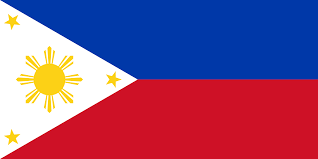Filipino flag Colors Code hex, png svg
The flag of the Philippines has a rich history and deep symbolism reflected in its design and colors. Here is a detailed overview:
History
- Design and Creation:
- The flag was first conceptualized by Emilio Aguinaldo, the leader of the Philippine revolutionary forces.
- It was sewn in Hong Kong by Marcela Agoncillo, her daughter Lorenza, and Delfina Herbosa de Natividad, a niece of Dr. Jose Rizal, the national hero of the Philippines.
- First Unveiling:
- The flag was officially unfurled during the declaration of Philippine independence from Spain on June 12, 1898, in Kawit, Cavite.
- Changes and Revisions:
- Over the years, the design of the flag underwent several modifications, primarily during the American colonial period and World War II.
- The current design was officially adopted on February 12, 1998, with Republic Act 8491, which codified the specifications and proper usage of the flag.
Colors and Their Meanings
- Blue:
- Symbolizes peace, truth, and justice.
- It represents the willingness of the Filipino people to strive for peace.
- Red:
- Represents patriotism and valor.
- It signifies the willingness of the Filipino people to shed blood for the defense of their country.
- White:
- Stands for purity and hope.
- It symbolizes the Filipinos’ desire for independence.
- Golden Yellow (Sun and Stars):
- The sun represents liberty and democracy.
- The eight rays of the sun stand for the first eight provinces that revolted against Spanish rule: Manila, Cavite, Batangas, Bulacan, Pampanga, Nueva Ecija, Tarlac, and Laguna.
- The three five-pointed stars represent the three main geographical regions of the Philippines: Luzon, Visayas, and Mindanao.
Symbolism in Usage
- The flag can be displayed with the blue field on top in times of peace.
- When the country is at war, the flag is inverted, with the red field on top.
Conclusion
The flag of the Philippines is not just a national symbol but also a representation of the country’s history, struggles, and aspirations. Each color and symbol holds significant meaning that reflects the Filipino spirit and heritage.
Guess the Flags Quiz
Sharing is caring 🤗

National Symbols 👇
- 🏁 National Flags
- 🦁 National Animals
- 🐦 National Birds
- 🌻 National Flowers
- 🌴 National Trees
- 🥭 National Fruits
- 🍹 National Drinks
- 👴 National Founders
- ☘️ National Emblems
- 🍲 National Dishes
- 🏛️ National Monuments
- ✍️ National Poets
- 🕌 National Mausoleums
- 🎺 National Instruments
- 🦸 National Heroes
- 📆 National Days

